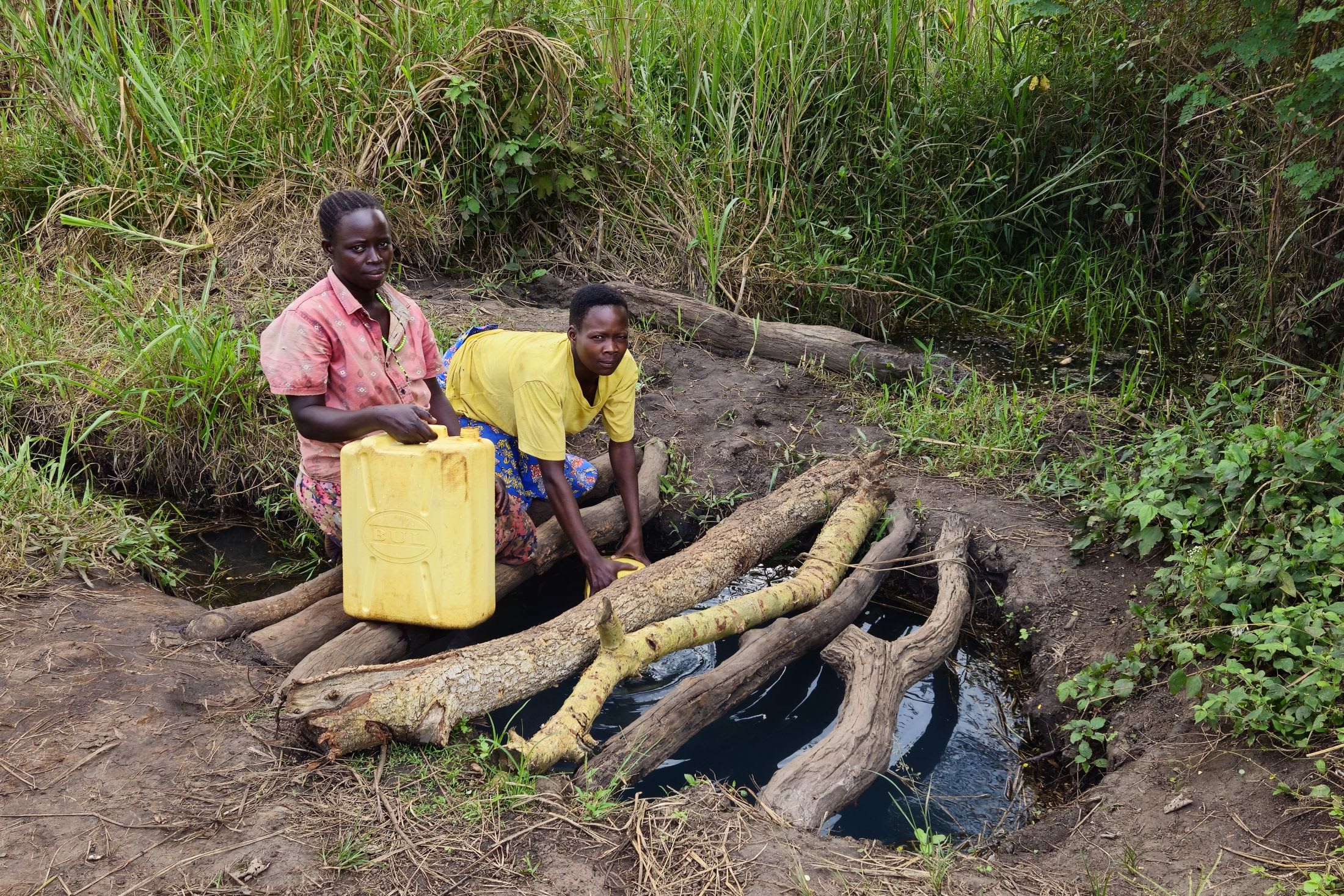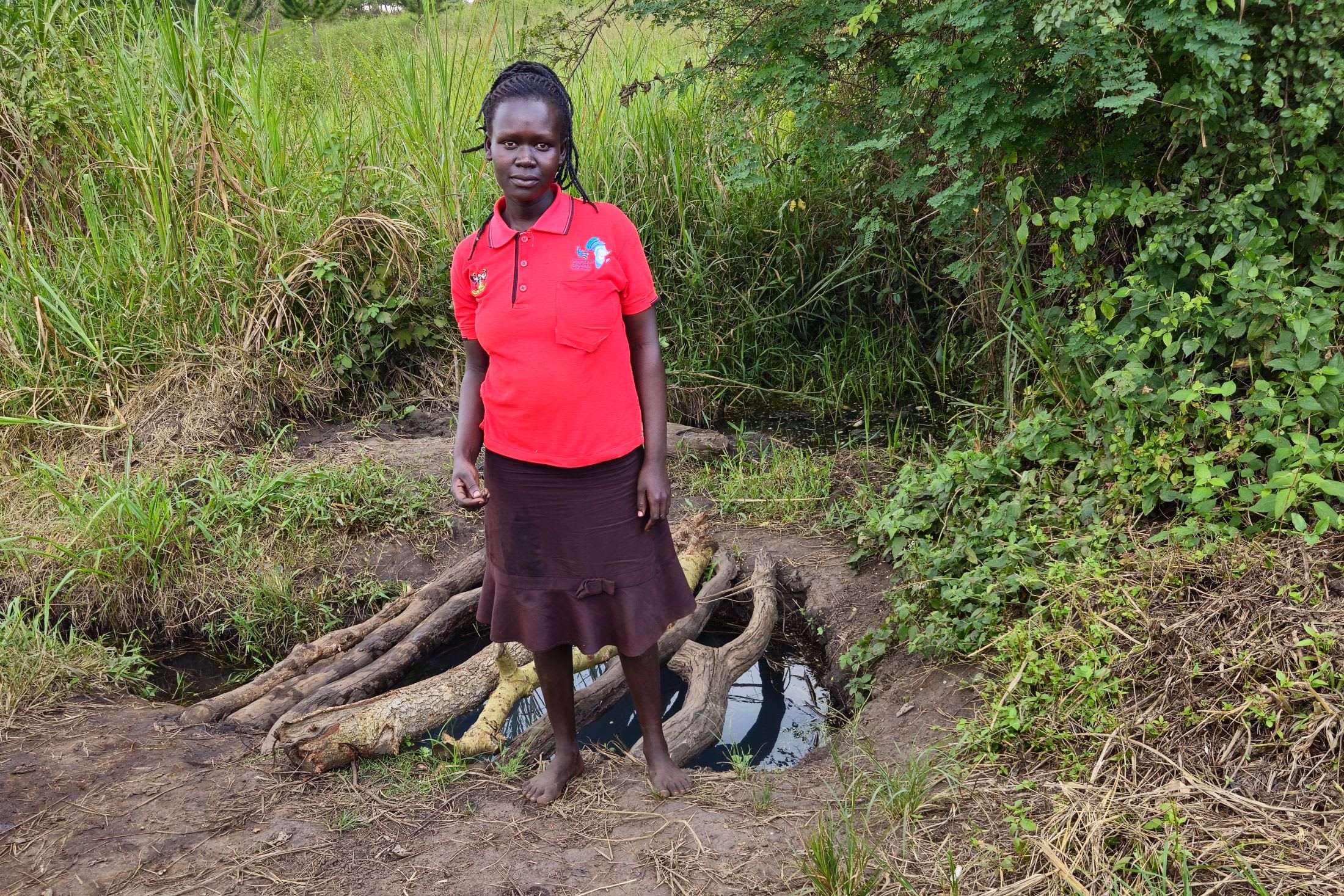The 250 people who live in Karungu Community do not have a safe, accessible water source to meet their daily needs.
"The access road to the well is in poor condition, making it unsafe. Additionally, the surrounding area is overgrown with bushes, which serve as hiding spots for snakes. These snakes occasionally venture near the waterpoint, causing fear and deterring people from accessing the water," said Field Officer Bena Nakabiri.

The small pool of water the community uses for daily needs is stagnant and covered with logs. People must kneel on the logs, slide their containers between them, and submerge them into the water to fill them. Many community members must make this tiring, difficult journey several times a day to meet their water needs.
"I fetch water five times a day because I need to wash clothes every day," said 23-year-old farmer Jennifer Chandiru.
Sadly, the difficult journey is not only exhausting, but all of that effort is for water that is threatening everyone's health. Consuming the contaminated water it provides causes people to suffer from waterborne illnesses like diarrhea and typhoid regularly.
"The open waterpoint is not safe and poses a significant risk, as there have been occasions when I found snakes there. It's not safe, as it impacts both my health and that of my family," said Jennifer.

Jennifer collecting water.
"The last time my child fell sick, I took her to the clinic for treatment. I had to borrow money from a neighbor to cover the expenses because I didn't have enough funds. I received medication from the clinic and paid for it. It causes me to spend a lot on medication, which impacts my income and savings," said Jennifer.
"My child also missed school while she was ill," Jennifer concluded.

When members of a community are afflicted by recurring illnesses due to the consumption of contaminated water, it not only endangers their well-being but also undermines their prospects for the future. The significant portion of their resources expended on seeking treatment hinders any potential advancements or improvements they could otherwise achieve.
Jennifer and her community require a reliable water source to guarantee access to safe, clean water for their daily needs. By meeting these needs, community members such as Jennifer will have the opportunity to pursue their dreams and support their families, breaking the cycle and empowering them to thrive.
Steps Toward a Solution
Our technical experts worked with the local community to identify the most effective solution to their water crisis. They decided to drill a borehole well, construct a platform for the well, and attach a hand pump.
Well
Abundant water often lies just beneath our feet. Aquifers—natural underground rivers—flow through layers of sediment and rock, offering a constant supply of safe water. A borehole well is drilled deep into the earth to access this naturally filtered and protected water. We penetrate meters, sometimes even hundreds of meters, of soil, silt, rock, and more to reach the water underground. Once found, we construct a platform for the well and attach a hand pump. The community gains a safe, enclosed water source capable of providing approximately five gallons of water per minute. Learn more here!
Community Education & Ownership
Hygiene and sanitation training are integral to our water projects. Training is tailored to each community's specific needs and includes key topics such as proper water handling, improved hygiene practices, disease transmission prevention, and care of the new water point. Safe water and improved hygiene habits foster a healthier future for everyone in the community. Encouraged and supported by the guidance of our team, a water user committee representative of the community's diverse members assumes responsibility for maintaining the water point, often gathering fees to ensure its upkeep.
A Community-Wide Approach
In Uganda, we use a Community-Led Total Sanitation (CLTS) approach, which involves several meetings where community members evaluate their own hygiene and sanitation practices to encourage lasting change. During these sessions, natural leaders emerge, motivating the community to recognize and change unhealthy behaviors that affect everyone.
Communities then commit to ending open defecation before we install the water project. Every household builds and uses a latrine to prevent disease and improve hygiene and sanitation alongside their new water source. To support this effort, a Community Development Officer (CDO) is assigned. The CDO encourages each household to set up handwashing stations, animal pens, garbage pits, and dish-drying racks. These additions are crucial in preventing the spread of common diseases.

 Borehole Well and Hand Pump
Borehole Well and Hand Pump
 Rehabilitation Project
Rehabilitation Project
























